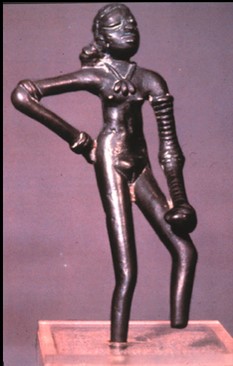Since ages India witnessed progress and development of Music and Dance. India has a vast and diverse history of learning and performing Music and Dance. Here you will learn everything about Music and Dance development in a simple and new way.
Development of Music and Dance in Stone age
The paintings and images found on the walls and rocks of Bhimbetka caves of the stone age period clearly tell us about the rich culture of dancing and singing on important occasions such as hunting, food gathering etc.
Group dance images found at Bhimbetka show us that they had developed the singing art also.
Development of Music and Dance in Harrapan Period
The Discovery of Mohenjodaro Dancing Bronze girl and Terracota Mother Goddess clearly depict that music and dance have developed to new heights during the Harappan Period.


Harp, a Veena like stringed musical instrument found on the seals of Lothal, Gujarat, portray the progress in the field of Music in Ancient India.
Progress in the field of Music and Dance during Vedic period
Udgatr Priest were responsible to preach or sung the musical hymns composition in the Samaveda. This data tells us that Music has taken a new shape in the Vedic era and its formal character appeared in the text. ( Hotri priest preach/sung Rig Veda hymns and Adhwaryu priest preach/sung Yajurveda hymns. No priest in Atharva Veda )
Gandharva ved, an Upaveda of Samaveda deals particularly with music.
Important point to note:
- Dhanurveda is the Upaveda of Rigveda.
- Shilpa Veda ( Craftsmen vishwakarma ) is the upaveda of Yajurveda.
- Ayurveda is the upaveda of Atharva Veda.
Dance and Music in the Post Vedic age
- Prostitute Amrapali was of high status, gifted mangoes to Mahatma Buddha.(6th CB)
- As per Vatsayana, the prostitutes were given formal training.
- Samudragupta is depicted as veena player on his coins
- Devadasis ( Temple dancers) , according to Kalidas, Many Devadasis were maintained in Mahakal temple of Ujjain.
Classic Indian Music
Art form which evolved through centuries/ages and is highly developed in present form is called Classical.
Indian Classic music is divided in two parts 1. Carnatic and Hindustani Music.
Carnatic Music
Purandaradasa is considered to be the father (Carnatic Sangeeta Pitamaha) of Carnatic music.
Thyagaraja, Muthuswamy Dikshitas and Shyama Shastri are famously known as Trinity of Carnatic music.
Hindustani Music
Hindustani music develops through the assimilation of regional Indian Music and Persian Music of Turks.
Learn more on Government Website.
